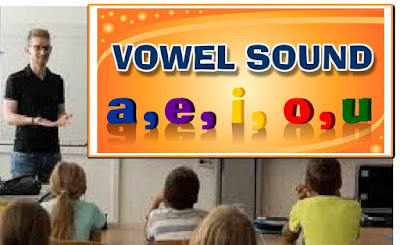Lesson Plan of Pure Vowels (Mono-thongs) & Gliding Vowels (Diphthongs)
Lesson Plan of Pure Vowels (Mono-thongs) & Gliding Vowels (Diphthongs)
Subject
English
SLO`s
- 1. Identify
and differentiate between vowel letters and sounds.
- 2. Pronounce
long and short vowel sounds in minimal pairs.
Information
for Teachers
- § (This plan be conducted in two lesson: lesson one for Pure Vowels (Monothongs, lesson 2 for Gliding Vowels (Diphthongs)
- § These
letters are pronounced without contact of the tongue, teeth, or lips, because
there is found no obstruction to the flow of air as it passes from the larynx
to the lips.
- § Basically, there are five vowels in English, but they make 20 sounds according to ‘Phonetics’. They are [a] [e] [i] [o] [u] (ee, ey, ah, oh, ooh) the basic vowels sound in English language. Letter ‘a’ is pronounced as in ant, ‘e’ is pronounced as in English, ‘I’ as in inkpot, ‘o’ as in oxen and ‘u’ as in put.
Short
and long Vowels sounds
- There are five short vowels sounds
- Sound – Example
- Short ‘a’ – and, as
- Short ‘e’ – pen, hen
- Short ‘I’ – it, in
- Short ‘o’ – top, hop
- Short ‘u’ – under, cup
Six
Long vowels sounds
- Sound – Example
- Long ‘a’ – make, take
- Long ‘e’ – beet, feet
- Long ‘I’ – tie, lie
- Long ‘o’ – coat, toe
- Long ‘u’ – rule, blue
§ While
teaching the lesson, the teacher should also consult the textbook where
applicable.
Material / Resources
Chalk,
blackboard, big cut-outs of the long and short vowel sounds made of card paper,(
Sample of sounds is attached with the plan). You must not cut this out from
here, but make your own based on the sample. Do practice exercise chart of
short vowel sounds (required for activity, make this chart so that model
reading and chanting can be done.
Introduction
- Introduce the vowels: write vowels a, e, I, o, u on the blackboard.
- Inform students that there are five vowels in English language with which we add “an” if the word starts with vowel letter or sound.
- Read the sound of letters like this: Letter ‘a’ is pronounced as in apple, ‘e’ is pronounced as in egg, ‘I’ as in ink, ‘o’ as in orange and ‘u’ as in umbrella.
Development
Activity
1
- Draw the following table on the board.
|
Short a |
Short e |
Short i |
Short o |
Short u |
|
Apple, ant |
Egg, elephant |
Ink, insect |
Orange, ox |
umbrella |
- Now pronounce these vowels and ask students to tell some words that start with these vowels. For example, ‘a’ in apple.
- Write \apple’ in ‘a’ column and ask them to add more words.
- Repeat this activity with rest of the vowels and keep pronouncing the words for their better understanding.
- Ask them to add shorter vowel sound words in the table.
- Students will make this table in their notebooks.
- Inform the students that these are words which start with short vowel sounds. Students must make this table in their notebooks.
Activity
2
- Display the short vowel exercise chart on the board.
- Read the words to the students.
- Make students practice to pronounce words by chanting / reading aloud.
Short
Vowel Sounds:
- A is for ambulance, ant, apricot, actor.
- A as in apple, not ay
- E is for exciting endings and extra eggs for everyone.
- E as in egg, not ee
- I as in ink, not eye
- O is for the old octopus eating an orange o as in ox, not oh
- U is for underneath, unusual, umbrellas
- U as in up, not you
Activity
3
Long
Vowel Sounds:
- Write the words cake, paper, feet, tie, coat, and rule, few on the black board.
- Pronounce each word and tell the vowel sound in each of the words 9’a’ in cake and paper, ‘ee’ in feet, ‘I’ in tie, ‘o’ in coat, ‘u’ in rule and few).Make refers to the instruction for teachers for clear understanding.
- Draw the following table on the writing board.
|
Long ‘a’ |
Long ‘e’ |
Long ‘I’ |
Long ‘o’ |
Long ‘u’ |
|
Cake, apron, late, cane, wave |
Feet, beet, meet, need |
Tie, lie, my, try |
Coat, toe, long, sort |
Rule, blue, few, (sound of ‘ew’ is
‘u’) |
- Ask them to tell words for each long vowel sound
- Tell them briefly when the vowel sound is long, long –e- in beet, feet, long –i- in tie, lie, long –o- in coat, toe, long –u- (yoo) in rule, long –oo- in few, blue then it is called long vowel sound.
- Repeat the long vowel sound words aloud at least five times.
- Correct for pronunciation.
- Ask all students to make the table of words in their notebooks.




Comments
Post a Comment